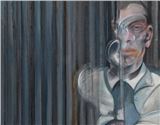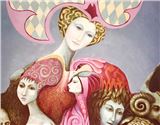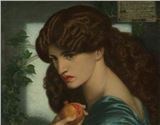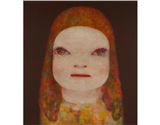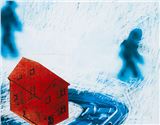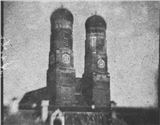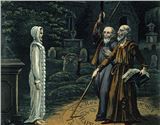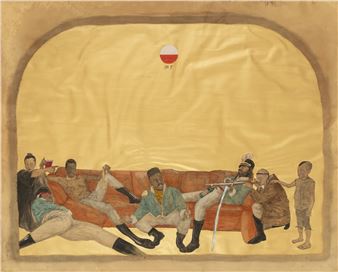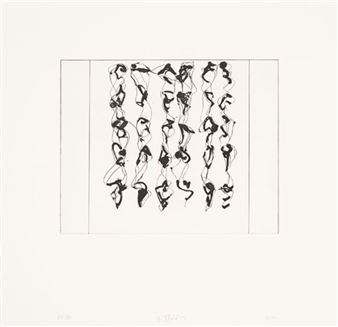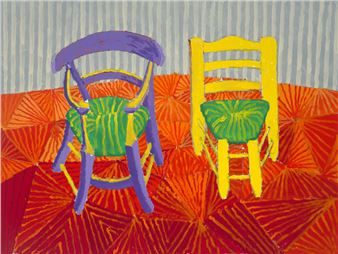Connections
Certain resonances occur within the exhibition, some localised but most shared between cities: the pop aesthetic in Blake, Rolph, Angel, Tilley and other's work from London, but also in EVA + ADELE's; the private, emblematic work of Nakahara, Hasenauer, Cho, Köppe, and Fecht, from Berlin, yet also found in Hara's. Other resonances are shared more broadly - the formal investigations of Badur, Ricci, Schmid, Shrigley, Slavnics, Terry, Connearn, Qualmann, Keserü and Scharp; the vitality of text in Smith, Lammert, Kochinke and Kindersley; the free and exploratory play of Schimannsky, Foá, ����ö�������, Murphy, Lubberger and Astor; the hermetic worlds and signs of �Ұ�ö�������, Baschlalow, Hegardt, Timofeev and Verran; the problematics of gesture in Richardson, Laroche, Buchanan, Auerbach, Hewish, Jenssen, Fox, Blaser, Scharp, Sill and Charman; the technological experimentation of Hockney, Koganezawa + Oya and Heath.
On entering, it is hoped that the viewer might think 'I know how this functions as art, but how does it fiunction as drawing?'. The artists selected here are ones that exemplify a variety of approaches to drawing. It is all too easy in the Contemporary context for drawing to be seen as contemporary image-making on paper; this does not account for the way drawing drags with it complex and disparate historical meanings particular to itself, all of which can brought to bear in the recognition of a work's status as a drawing.
This particular set of meanings and questions are ones that drawing artists engage with in their daily practice. Like any art of today, drawing can be considered completed by the viewer; but in completing the circuit of a drawing, a special kind of complexity filter is introduced. In an age of art where much is focused on a final outcome, be it product or conclusive meaning or image for the viewer, drawing offers a refreshing alternative.
Drawing has associations with being fragile, or temporary, containing gestures that are as much fleeting ideas as they might be marks on the page. It recalls time. It can rely on networks, of points in space or page, that are necessarily connected in the completion of the work; points that make stories, pathways, or forms. It can be closely associated with the interior life of the artist, their passions and intentions, that can be subsumed by systems or processes, or engage a subtle negotiation between consciousness, technic and ground.
We can connect, along the lines, the mindfulness, or otherwise, of the artist. It often engages directly the body of the artist, tracing their movement, allowing the viewer direct access to the record of its own making. It can love its own materiality. It can spectacularly stimulate our vision. It can graph data; write language. It can promote stages of development, or lyrical leaps of imagination. It can articulate imaginative space, or record observed space. It can draw on its own visual language, blending different traditions to forge new meanings. It is the exercise of imagination on line.
Certain resonances occur within the exhibition, some localised but most shared between cities: the pop aesthetic in Blake, Rolph, Angel, Tilley and other's work from London, but also in EVA + ADELE's; the private, emblematic work of Nakahara, Hasenauer, Cho, Köppe, and Fecht, from Berlin, yet also found in Hara's. Other resonances are shared more broadly - the formal investigations of Badur, Ricci, Schmid, Shrigley, Slavnics, Terry, Connearn, Qualmann, Keserü and Scharp; the vitality of text in Smith, Lammert, Kochinke and Kindersley; the free and exploratory play of Schimannsky, Foá, ����ö�������, Murphy, Lubberger and Astor; the hermetic worlds and signs of �Ұ�ö�������, Baschlalow, Hegardt, Timofeev and Verran; the problematics of gesture in Richardson, Laroche, Buchanan, Auerbach, Hewish, Jenssen, Fox, Blaser, Scharp, Sill and Charman; the technological experimentation of Hockney, Koganezawa + Oya and Heath.
On entering, it is hoped that the viewer might think 'I know how this functions as art, but how does it fiunction as drawing?'. The artists selected here are ones that exemplify a variety of approaches to drawing. It is all too easy in the Contemporary context for drawing to be seen as contemporary image-making on paper; this does not account for the way drawing drags with it complex and disparate historical meanings particular to itself, all of which can brought to bear in the recognition of a work's status as a drawing.
This particular set of meanings and questions are ones that drawing artists engage with in their daily practice. Like any art of today, drawing can be considered completed by the viewer; but in completing the circuit of a drawing, a special kind of complexity filter is introduced. In an age of art where much is focused on a final outcome, be it product or conclusive meaning or image for the viewer, drawing offers a refreshing alternative.
Drawing has associations with being fragile, or temporary, containing gestures that are as much fleeting ideas as they might be marks on the page. It recalls time. It can rely on networks, of points in space or page, that are necessarily connected in the completion of the work; points that make stories, pathways, or forms. It can be closely associated with the interior life of the artist, their passions and intentions, that can be subsumed by systems or processes, or engage a subtle negotiation between consciousness, technic and ground.
We can connect, along the lines, the mindfulness, or otherwise, of the artist. It often engages directly the body of the artist, tracing their movement, allowing the viewer direct access to the record of its own making. It can love its own materiality. It can spectacularly stimulate our vision. It can graph data; write language. It can promote stages of development, or lyrical leaps of imagination. It can articulate imaginative space, or record observed space. It can draw on its own visual language, blending different traditions to forge new meanings. It is the exercise of imagination on line.
Artists on show
- Andreas Schmid
- Astrid Köppe
- Bertram Hasenauer
- Björn Hegardt
- Claude Heath
- Danny Rolph
- David Connearn
- David Hockney
- David Kindersley
- Dennis Scholl
- Eva & Adele
- Frances Richardson
- Frank Auerbach
- Frank Badur
- Hanns Schimansky
- Heidi Sill
- Helen Cho
- Irina Baschlakow
- Jorinde Voigt
- Kate Smith
- Marc Gröszer
- Nick Fox
- Olav Christopher Jenssen
- Paco Knöller
- Peter Blake
- Scott Blazer
- Takehito Koganezawa
- Ulrich Kochinke
Contact details


 ARTISTS
ARTISTS
